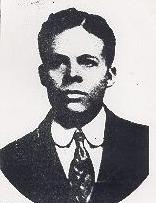George Wells Parker facts for kids
George Wells Parker was an important African-American leader. He was born in 1882 and passed away in 1931. Parker was a political activist, a historian, and a writer. He helped start a group called the Hamitic League of the World. This group worked to promote pride in African heritage.
Contents
Early Life and Education
George Wells Parker's family moved to Omaha, Nebraska, when he was young. His parents were from Virginia and South Carolina. While attending Omaha Central High School, he was known as a leader. He was also a very good speaker.
In 1898, Parker entered a national essay contest. This contest was for high school and college students. It was held at the Trans-Mississippi and International Exposition. Parker won top honors for his essay about history. After high school, he studied at Howard University for a few years. Later, he returned to Omaha and studied medicine at Creighton University.
Working for Change
In 1916, Parker began helping African Americans move to and settle in Omaha. By 1917, he helped create the Hamitic League of the World. This group aimed to encourage pride in African heritage. It also worked for the economic success of Black people.
During this time, Parker was also a leader in the Omaha Philosophical Society. He often gave speeches there. These speeches were about the history of African Americans.
Newspaper Work
Parker was a regular writer and editor for The Monitor. This was a Black newspaper in Omaha. After leaving The Monitor in 1921, he edited another Black newspaper. This paper was called The New Era, but it did not last long.
In 1922, Parker moved to Chicago. He wanted to work more in newspapers and magazines there. He passed away in Chicago almost ten years later. He was buried in an unmarked grave in Forest Lawn Cemetery in Omaha.
Parker's Ideas and Influence
George Wells Parker believed strongly in the importance of African history. He was a Black nationalist, meaning he focused on the unity and self-determination of Black people. His ideas about Africa being the "cradle of civilization" were very forward-thinking. They helped inspire a greater interest in ancient Egyptian culture among African Americans.
Revising History Books
As a historian, Parker wanted to help Black people learn more about their past. He called for new textbooks. These books would correct false information. They would also include the true history of Black people.
In 1917, Parker gave a lecture in Omaha. It was titled "The African Origin of the Grecian Civilization." This lecture was later published in the Journal of Negro History. Parker argued that new research showed that ancient civilizations, like those in Mesopotamia and Greece, had African roots.
In 1918, the Hamitic League published his pamphlet, "Children of the Sun." This writing further explained his ideas. It talked about the African origins found in classical Egyptian, Asian, and European civilizations. A famous author and historian, Joel Augustus Rogers, found this publication very helpful for his own work.
Working with Other Leaders
Parker's ideas influenced other leaders, like Cyril Briggs. Briggs was a journalist from the Caribbean. He started a group called the African Blood Brotherhood in New York City. Parker's Hamitic League and Briggs's group sometimes worked together. For example, The Crusader was a publication of the Hamitic League. It was actually edited by Cyril Briggs in September 1918. This showed how these two important groups worked to share their messages.


